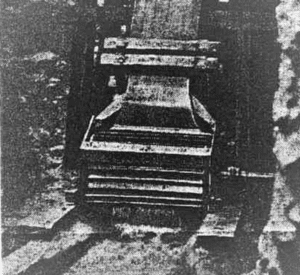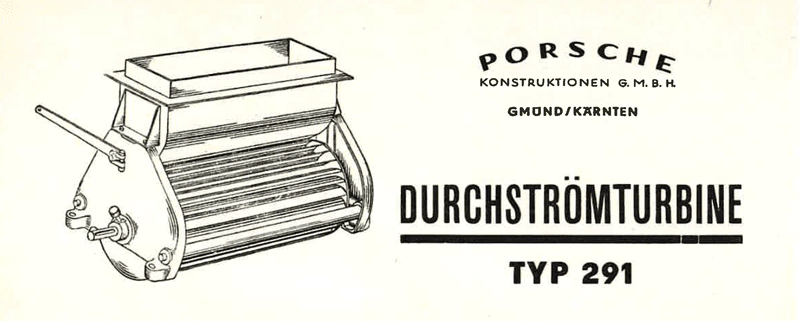Original 1949 Porsche Konstruktionen GesmbH (Gmünd) water turbine now in fahr(T)raum
In the years between 1944 and 1950, the Porsche works in Gmünd/Carinthia, which operated under the name Porsche-Konstruktionen-Ges.m.b.H., produced not only the Porsche 356 No. 1 Roadster but also designs for racing cars, tractors, cable winches, ski lifts and crossflow turbines.
The Type 291 crossflow turbine – on loan from the Porsche Automuseum in Gmünd – is currently on exhibit at fahr(T)raum. “We have been working together with the Porsche Museum in Gmünd for a long time and have a very strong and dear partner in the Pfeifhofer family,” says Jakob Iglhauser, Managing Director of the fahr(T)raum classic car museum in Mattsee near Salzburg.
 The turbine was used, inter alia, to drive sawmills, mills and agricultural machinery. It was also used to generate electricity. The advantage over the traditional water wheel was the significantly higher speed of the turbine, with which a higher output – even with a smaller water volume – could be achieved. The nozzle could be regulated by hand. The turbine was recommended for the “economic utilisation of small hydropower plants” for a power output of 4 to 20 HP for a fall height (drop) of 2.4 to 6 metres or a power output of 40 HP for a drop of 10 metres. It consists mainly of sheet steel parts welded together, the impeller runs on ball bearings. According to the original instruction handbook, maintenance is limited “to daily retightening of the lubricators provided on the bearing bodies and refilling these lubricators with grease after a longer period of operation.”
The turbine was used, inter alia, to drive sawmills, mills and agricultural machinery. It was also used to generate electricity. The advantage over the traditional water wheel was the significantly higher speed of the turbine, with which a higher output – even with a smaller water volume – could be achieved. The nozzle could be regulated by hand. The turbine was recommended for the “economic utilisation of small hydropower plants” for a power output of 4 to 20 HP for a fall height (drop) of 2.4 to 6 metres or a power output of 40 HP for a drop of 10 metres. It consists mainly of sheet steel parts welded together, the impeller runs on ball bearings. According to the original instruction handbook, maintenance is limited “to daily retightening of the lubricators provided on the bearing bodies and refilling these lubricators with grease after a longer period of operation.”
The turbine was produced in two types – type 291/1 (490 kg, max. height 760 mm, max. length 1250 mm) and type 291/2 (390 kg, max. height 740 mm, max. length 750 mm). The purchase and installation of the turbine was affordable even for economically weak mining operations.
Originally, the crossflow turbine was invented as early as 1903 by Anthony George Michell in Melbourne. Improvements were first made by Professor Donat Bánki from Budapest and later by Ing. Erwin Sonneck.
How does the water in the crossflow turbine work? The answer to this question, as well as further technical details on how the turbine works, can be found in the current classic car exhibition at Ferdinand Porsche’s worlds of experience fahr(T)raum !







Gunter Haug reads from his book “Ferdinand Porsche – Ein Mythos wird geboren”
/in Geschichte, Lebensstationen, Non categorizzatoOn 15 March we will be welcoming Gunter Haug to fahr(T)raum Mattsee. The author will perform a reading of his work “Ferdinand Porsche – Ein Mythos wird geboren / A myth is born” in German at 7:30 pm. The newspaper, radio and television editor and author of more than 30 books has dealt with the […]
Ferdinand Porsche at Austro-Daimler – Career highlights
/in Geschichte, Lebensstationen, Non categorizzato, Rennautos, Sonstige FahrzeugeFollowing the departure of Paul Daimler from the Austro-Daimler plants in Wiener Neustadt in 1905 – he replaced Wilhelm Maybach in the design office in Stuttgart – Emil Jellinek, diplomat and businessman, participated in the company. He transformed what he considered the “obsolete” plant into a modern car factory and brought a brilliant young engineer […]
Auto Union Type C – most successful German Grand Prix racing car in 1936!
/in Geschichte, Motoren, Non categorizzato, RennautosThe Auto Union Type C was the most successful German Grand Prix racing car in 1936. It won three out of five Grand Prix races, half of the circuit races and all hill-climbs in which Auto Union participated. In addition, the Type C set more than thirty world records. In order to minimise the financial […]